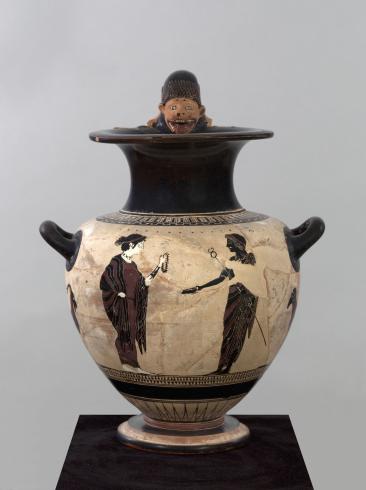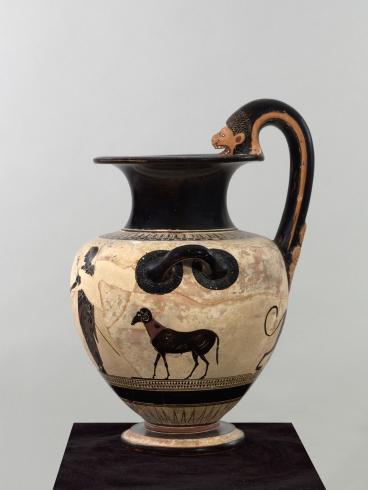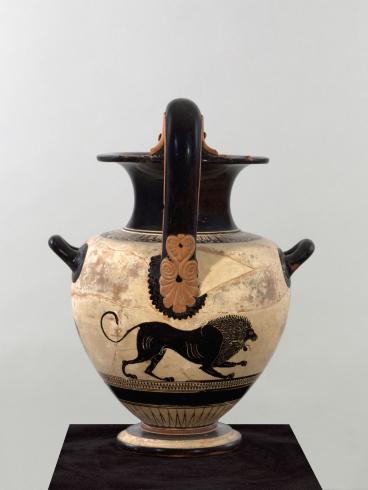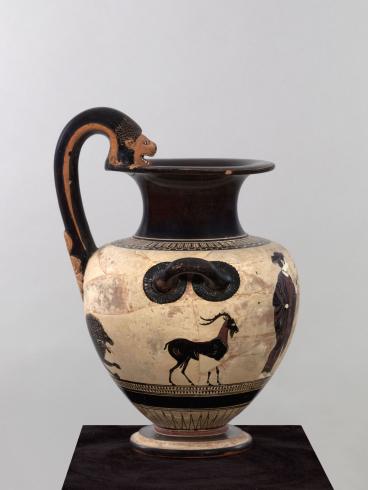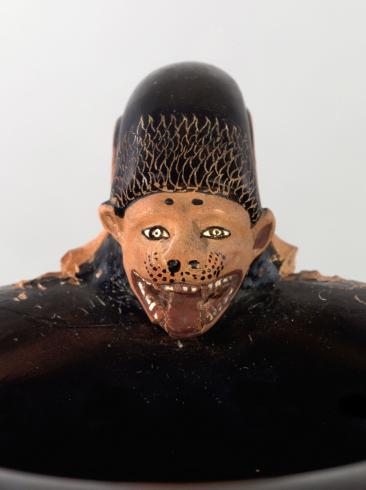The exceptional nature of this piece is matched by the originality of the painted composition. In the absence of the traditional framework, the image unfolds along the circumference of the hydria, thus gaining in sober monumentality. At the center of the main side, two figures in profile stand facing each other on a simple ground line: shown in black figure, they occupy the full height of the belly, with the female skin tone painted in white on the black varnish. Visually isolated, they are flanked, beneath the horizontal handles, by a goat to the left and a ram to the right. Under the vertical handle is a roaring lion. The meticulously incised drawing is complemented by a host of white, black and red highlights. The partially conserved painted inscriptions name the figures - Hermes and Maia - in small, neat script, together with the mention " ΚΑΡΥΣΤΙΟΣ ΚΑΛΟΣ" (Karystios is beautiful).
Clear as the identity of the figures may be, the interpretation of the scene - the only of its kind - is problematical. The rendering of Hermes - young and beardless, with short curly hair, and facing his mother Maia - is most unusual: as a rule he is shown as a child or a bearded adult. The choice of animals - goat, ram, lion - seems to suggest Hermes'role as a divine conductor of souls to the afterworld. The youthful portrayal of someone usually shown in his maturity is a gambit this artist used on a number of occasions.
The applied ornamentation on the vertical handle is equally rare, especially the lion's head at the top, a three-dimensional echo of the roaring lion drawn underneath. The affinities between the style of the painter and that of the potter have been noted on two white ground pieces decorated by Psiax, and the same is true here. Such is the imbrication of form, technique and ornamentation that the hypothesis of a painter/potter cannot be excluded. Indeed, given Psiax's debt to his master, the Amasis Painter - very probably a painter/potter himself - and the part Psiax played in training Euphronios, his most brilliant pupil and an accomplished painter/potter, the assumption seems justifiable.
As often in this case, the piece bears no signature. Of all the works attributed to Psiax, only two alabasters are signed: one from Athens, now in Karlsruhe, the other in Odessa.
P. P.-H.

City of Paris municipal collection's website
The collections portal can be used to search the collections of Paris’s 14 municipal museums (approximately 336,000 works, including 43,000 belonging to the Petit Palais).
It is also possible to download around 12,000 images of the museum’s works free of charge.
Access the Museums of the City of Paris collections portal
Extern databases
Discover a selection of databases online presenting works from the Petit Palais or documents concerning the history of the museum.

